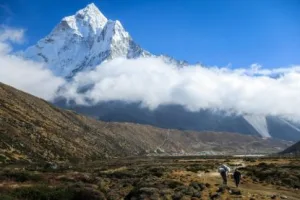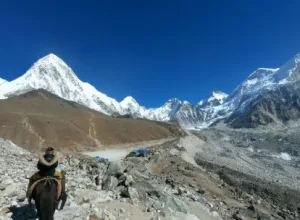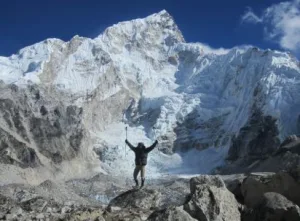Everest Base Camp Trek Cost and Itinerary – 12 Day Adventure

The Everest Base Camp Trek is one of the most iconic and breathtaking treks in the world. Located in the heart of Nepal’s Khumbu region, this legendary trail leads you to the foot of the world’s highest mountain—Mount Everest (8,848.86 meters). The trip to Everest Base Camp( EBC) is n’t just a journey; it’s an artistic, spiritual, and physical adventure that offers a formerly- by-a-lifetime experience. Whether you are an educated mountaineer or a first- time mountain nut, this 12- day Everest Base Camp diary is designed to give stunning Himalayan views, Sherpa hospitality, and indelible recollections.
Highlights of the Trek:
- Walk to the base of the world’s highest peak, Mount Everest.
- Explore Sherpa villages and experience their rich culture.
- Visit the famous Tengboche Monastery with Everest views.
- Enjoy panoramic Himalayan scenery from Kala Patthar.
- Trek through the Sagarmatha National Park (UNESCO-listed).
- Cross thrilling suspension bridges and alpine forests.
- Stay in traditional tea houses with local meals and warmth.
- Fly into and out of Lukla—one of the world’s most adventurous airports.
Why Choose This Trek
Choosing the Everest Base Camp Trek is choosing a journey that combines challenge, beauty, culture, and reward. Here’s why thousands of trekkers from across the world take this trail every year:This trek lets you substantiate the muscle of Everest not just from a distance, but from its very base. You’ll walk among the loftiest mountains on Earth — Lhotse, Nuptse, Ama Dablam, and more. The original Sherpa culture is deeply spiritual and welcoming. You’ll visit Buddhist cloisters, spin prayer buses, and sleep in traditional tea houses. This is also a particular challenge. Climbing to 5,364 measures tests your abidance and internal strength, making success at EBC deeply satisfying. Despite its high- altitude, the journey does n’t bear specialized climbing chops, making it accessible to fit newcomers with good medication. Still, adventure, and pushing your boundaries If you love nature.—this trek is for you.
Everest Base Camp Trek Itinerary – 12 Days

The 12 days is Best Everest Base camp Trek Itinerary The Itinerary starts from and end to Kathmandu. and It offers the perfect balance of adventure, acclimatization, and scenic exploration. Designed for trekkers with limited time, it includes all major highlights—Lukla flight, Namche Bazaar, Tengboche Monastery, and Kala Patthar—while ensuring a safe ascent with proper altitude adjustments. This trek allows you to experience the culture of the Sherpa people, breathtaking views of Everest and neighboring peaks, and the majestic Khumbu Glacier. It’s ideal for moderately fit travelers seeking an unforgettable Himalayan journey without the need for extended leave. The 12-day plan is efficient, immersive, and structured to minimize risks of altitude sickness.
Day 1: Fly to Lukla (2,840m) and Trek to Phakding (2,610m)
Take a scenic early morning flight from Kathmandu to Lukla. Begin trekking through pine forests and cross hanging bridges to reach Phakding.
Duration: 3–4 hours
Day 2: Trek to Namche Bazaar (3,440m)
Walk along the Dudh Koshi River, cross suspension bridges, and enter Sagarmatha National Park. A steep ascent brings you to Namche—Sherpa capital.
Duration: 6–7 hours
Day 3: Acclimatization Day at Namche Bazaar
Take a rest day for altitude adjustment. Hike to Everest View Hotel or Khumjung village and explore Namche’s markets and museums.
Day 4: Trek to Tengboche (3,860m)
A beautiful trail with mountain views leads to the spiritual center of the region—Tengboche Monastery.
Duration: 5–6 hours
Day 5: Trek to Dingboche (4,410m)
Descend through rhododendron forest and climb toward the windy, open spaces of Dingboche.
Duration: 5–6 hours
Day 6: Acclimatization Day at Dingboche
Take a short hike to Nangkartshang Peak or Chukhung for excellent views of Makalu and Ama Dablam.
Day 7: Trek to Lobuche (4,940m)
Pass the memorials of lost climbers and trek through alpine terrain with dramatic views.
Duration: 5–6 hours
Day 8: Trek to Gorak Shep (5,160m) and Everest Base Camp (5,364m)
Reach Gorakshep, then take a side trek to Everest Base Camp. Return to Gorak Shep for the night.
Duration: 7–8 hours
Day 9: Hike Kala Patthar (5,545m) and Trek to Pheriche (4,240m)
Climb early to Kala Patthar for sunrise over Everest, then descend to Pheriche.
Duration: 7–8 hours
Day 10: Trek to Namche Bazaar
Retrace steps through Tengboche and lush forest trails to Namche.
Duration: 6–7 hours
Day 11: Trek to Lukla
Final day of trekking, ending with a night at Lukla to prepare for departure.
Duration: 6–7 hours
Day 12: Fly to Kathmandu
Take the morning flight back to Kathmandu and celebrate the successful completion of your adventure.
Best Time to Trek Everest Base Camp

Trekking to Everest Base Camp is a dream adventure, and choosing the best time is crucial for safety and scenic beauty. The ideal seasons—spring (March to May) and autumn (September to November)—offer clear skies, stable weather, and stunning mountain views. Understanding when to go ensures a rewarding journey with fewer risks and the most breathtaking Himalayan experience.
The best seasons for Everest Base Camp trekking are:
Spring (March to May)
This is the most popular season. Clear skies, mild temperatures, blooming rhododendrons, and excellent views make it perfect.
Autumn (September to November)
Another ideal window. Stable weather, post-monsoon clarity, and festive vibes with local celebrations like Dashain and Tihar.
Winter (December to February)
Less crowded, but very cold. Suitable only for well-prepared trekkers. Trails remain open but may be icy.
Monsoon (June to August)
Not recommended due to heavy rain, landslides, and cloudy skies. However, there are fewer tourists and lush landscapes.
Everest Base Camp Trek Cost
The Everest Base Camp Trek cost is a key consideration for anyone planning this iconic Himalayan journey. Understanding the cost helps trekkers budget wisely and prepare for what’s ahead. The total expense depends on factors like permits, guide and porter services, accommodation, meals, transportation, and gear rental. While some trekkers prefer budget options, others may opt for mid-range or luxury packages. Costs can also vary by season and level of customization. Knowing the average price range ensures there are no surprises, allowing you to fully enjoy the trek to Everest’s doorstep with peace of mind and financial clarity.
1. Trekking Package Price: $1,200 – $2,000
Includes permits, guides, porters, food, accommodation, airport transfers, and flights to Lukla.
2. Independent Trekking Cost
If trekking without a guide (not recommended), expect:
- Lukla flights: $400–$500 round trip
- Permits: $50–$60 total
- Food & lodging: $25–$40 per day
- Porter/guide: $20–$30 per day (each)
- Misc: $100 (Wi-Fi, charging, showers, tips)
Total independent cost ranges between $900–$1,300.
Note: As of 2023, solo trekking is banned in the Everest region without a licensed guide.
Food, Accommodation, and Culture
Food:
Anticipate traditional Nepali reflections like dal bhat( lentils and rice), polls, momos( dumplings), and flapjacks. Advanced mounds offer simpler menus. utmost tea houses give warm reflections with submissive options.
Accommodation
You’ll stay in tea houses( mountain lodges). Basic apartments with binary beds, participating toilets, and collaborative dining halls. Some offer hot showers and Wi- Fi at a redundant cost.
Culture
The Khumbu region is the motherland of the Sherpa people — notorious Himalayan perambulators and devout Buddhists. Visit cloisters, substantiation prayer flags fluttering in the wind, and feel the peaceful, spiritual energy of the Himalayas.
Packing List
Here’s what to pack for the Everest Base Camp Trek:
Clothing:
- Waterproof trekking boots
- Thermal base layers (tops & bottoms)
- Fleece jacket and down jacket
- Trekking pants (2–3 pairs)
- Windproof/waterproof jacket
- Gloves, hat, and neck gaiter
- Sunglasses and sun hat
Gear:
- Backpack (30–40L for daily use)
- Sleeping bag (-10°C or lower)
- Trekking poles
- Water bottles or hydration bladder
- Headlamp with extra batteries
- Power bank and chargers
Toiletries & Essentials:
- Sunscreen and lip balm (SPF 50)
- Toilet paper and wet wipes
- First aid kit
- Personal medications
- Hand sanitizer and soap
Tip: Pack light. Porters have a weight limit of 10–12 kg per trekker.
Tips for a Successful Tour
- Train in advance: Start cardio and leg-strengthening exercises at least 2 months before your trek.
- Stay hydrated: Drink at least 3–4 liters of water daily.
- Acclimatize properly: Don’t skip rest days. Altitude sickness can hit anyone.
- Follow your guide: Don’t rush or ignore their advice.
- Eat well and sleep early: Energy and recovery are crucial.
- Layer your clothing: Weather changes quickly in the Himalayas.
- Carry cash: There are no ATMs on the trail. Carry enough Nepalese Rupees from Kathmandu.
- Respect local customs: Be mindful in monasteries and villages. Say “Namaste” and ask before taking photos.
Conclusion
The Everest Base Camp Trek (12 Days) is more than a trail—it’s a path to personal transformation. You’ll challenge your body, calm your mind, and lift your soul under the murk of the topmost mountains on Earth. With a well- planned diary, proper guidance, and a heart ready for adventure, this journey becomes an indelible trip. The Sherpa smiles, fluttering prayer flags, deep dens , and icy peaks will live in your memory long after you return. Whether you’re doing it to tick off a pail list point or to witness the magic of the Himalayas, this 12- day Everest Base Camp journey is a gift you’ll norway lament giving yourself.
FAQs
1. Is the Everest Base Camp Trek difficult?
It’s a moderately challenging trek. No climbing skills needed, but good fitness and stamina are essential due to high altitude.
2. Can beginners do the trek?
Yes, with proper preparation and guidance. Many first-time trekkers successfully complete it.
3. Do I need a guide?
Yes, from 2023, trekking with a licensed guide is mandatory for safety.
4. What permits are required?
You need the Sagarmatha National Park Permit and Khumbu Pasang Lhamu Rural Municipality Permit.
5. Are Lukla flights safe?
Yes, but flights are weather-dependent. Always allow buffer days in your itinerary.
6. What’s the maximum altitude reached?
Kala Patthar at 5,545m is the highest point for trekkers.
7. Is the internet available?
Yes, but it’s slow and paid. Buy an Ncell SIM or Everest Link Wi-Fi access.
